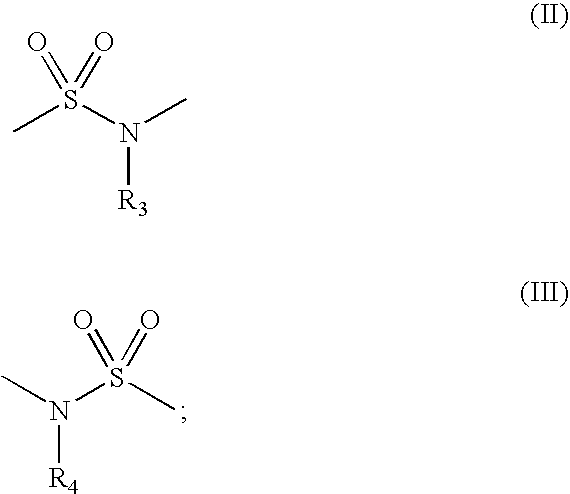Inhibitors of histone deacetylase for the treatment of disease
a histone deacetylase and inhibitory technology, applied in the direction of heterocyclic compound active ingredients, biocide, drug compositions, etc., can solve the problems of poor in vivo stability, poor pharmacokinetic profiles, and low oral bioavailability of hydroxamate-based compounds, so as to inhibit the catalytic activity and cellular function of hdac, and the treatment or prophylaxis of a disease.
- Summary
- Abstract
- Description
- Claims
- Application Information
AI Technical Summary
Benefits of technology
Problems solved by technology
Method used
Image
Examples
example 1
Thioacetic acid S-(2-{6-[4-(3-dimethylamino-propoxy)-benzenesulfonylamino]-pyridin-3-yl}-2-oxo-ethyl)ester
[0222]
Step 1: N,N-dimethyl-3-phenoxypropan-1-amine
[0223]
[0224] Into a 5 L 3-necked round-bottom flask was placed a solution of 1-(3-bromopropoxy)benzene (250 g, 1.16 mol) in THF (600 ml). To this was added dimethylamine in water (1 L 33%). To the mixture was added KOH (200 g, 4.46 mol). The resulting solution was allowed to react, with stirring, for 5 hours while the temperature was maintained at room temperature. The reaction progress was monitored by TLC (EtOAc / PE=1:3). The resulting solution was extracted five times with 200 ml of EtOAc and the organic layers combined. The filtrate was concentrated by evaporation under vacuum using a rotary evaporator. This resulted in 200 g of crude N,N-dimethyl-3-phenoxypropan-1-amine as light yellow oil.
Step 2: 4-[3-(dimethylamino)propoxy]benzenesulfonyl chloride
[0225]
[0226] Into a 2 L 3-necked roundbottom flask, was placed a solution ...
example 2
[0233]
Thioacetic acid S-(2-{6-[4-(2-dimethylamino-ethoxy)-benzenesulfonylamino]-pyridin-3-yl}-2-oxo-ethyl) ester
Step 1: N-(5-Acetyl-pyridin-2-yl)-4-iodo-benzenesulfonamide
[0234]
[0235] 4-Iodo-benzenesulfonyl chloride (83 g, 274 mmol, 1 eq) was added over a period of 1 min to 1-(6-amino-pyridin-3-yl)-ethanone (42 g, 301 mmol, 1.1 eq) dissolved in pyridine (350 mL). The resulting mixture was heated to 60° C. for 90 min with vigorous stirring and then cooled to room temperature. The reaction mixture was then poured (over a period of 1 min) into stirring 2N HCl (2.6 L). The off-white slurry was stirred for 1 h and filtered to give an off-white solid which was then triturated in MeOH (1.2 L) for 1 h, filtered, triturated further in DCM (200 mL) for 30 min, filtered, and dried to afford 94 g (85%) of N-(5-Acetyl-pyridin-2-yl)-4-iodo-benzenesulfonamide as an off-white solid. 1H-NMR (400 MHz, DMSO-d6) δ 8.60 (s, 1H), 8.15 (d, 1H), 7.93 (d, 2H), 7.66 (d, 2H), 7.22 (d, 1H), 2.48 (s, 3H); [M+...
example 3
[0240]
Thioacetic acid S-(2-{6-[4-(3-dimethylamino-2,2-dimethyl-propoxy)-benzenesulfonylamino]-pyridin-3-yl}-2-oxo-ethyl) ester
[0241] Thioacetic acid S-(2-{6-[4-(3-dimethylamino-2,2-dimethyl-propoxy)-benzenesulfonylamino]-pyridin-3-yl}-2-oxo-ethyl) ester was synthesized as described in EXAMPLE 2 using N-(5-acetyl-pyridin-2-yl)-4-iodo-benzenesulfonamide and 3-dimethylamino-2,2-dimethyl-propan-1-ol as starting materials. 1H NMR (400 MHz, CD3OD) δ 8.72 (s, 1H), 8.18 (d, 1H), 7.97 (d, 2H), 7.21 (d, 1H), 7.14 (d, 2H), 4.32 (s, 2H), 3.96 (s, 2H), 2.96 (s, 6H), 2.37 (s, 3H), 2.30 (s, 2H), 1.21 (s, 6H). LCMS: 481 (M+1).
PUM
| Property | Measurement | Unit |
|---|---|---|
| Catalytic activity | aaaaa | aaaaa |
| Chemotherapeutic properties | aaaaa | aaaaa |
Abstract
Description
Claims
Application Information
 Login to View More
Login to View More - R&D
- Intellectual Property
- Life Sciences
- Materials
- Tech Scout
- Unparalleled Data Quality
- Higher Quality Content
- 60% Fewer Hallucinations
Browse by: Latest US Patents, China's latest patents, Technical Efficacy Thesaurus, Application Domain, Technology Topic, Popular Technical Reports.
© 2025 PatSnap. All rights reserved.Legal|Privacy policy|Modern Slavery Act Transparency Statement|Sitemap|About US| Contact US: help@patsnap.com



